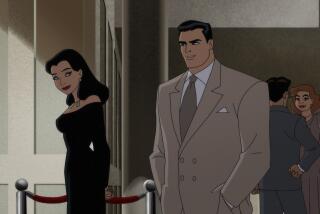Comic Canon 101 : TOM SAWYER.<i> By Mark Twain</i> .<i> Acclaim: 64 pp., $4.99</i> : A TALE OF TWO CITIES.<i> By Charles Dickens</i> .<i> Acclaim: 64 pp., $4.99</i> : ROMEO AND JULIET.<i> By William Shakespeare</i> .<i> Acclaim: 64 pp., $4.99</i>
The small boy, 8 years old and just beginning to discover the wonder of books, snuggled into his bed with his treasure, a new comic book. His mother had given him an extra 10 minutes before “lights out” to read. He had raced through the beginning of the story after dinner and now was time for the grand finale. He opened the precious gift to the last pages, picked up where he left off and again plunged into the exotic world of Patusan, a land of adventure and wonder.
Shirt torn, muscles rippling, the hero stood, ready to face his fate. At his feet lay his best friend, shot to death because of his error, shot to death for having faith in him. “I am come in sorrow,” he said to the chief, “I am come ready and unarmed.”
The aged chief, a monumental hulk of a man, rose with effort, dropping a ring that rolled toward the feet of the hero. Anger roiled the chief’s face as he struggled to his feet and shot the hero with an ancient sidearm. The hero clutched his heart, looked to the villagers on both sides as if asking forgiveness, and pitched forward, dead, over the body of his friend, the chief’s only son.
After lights out, the boy, satisfied, head on his pillow, played back the images of good guys and bad guys in his head, dreaming of the day he would go into the world and have his own adventures.
Was the boy reading the latest X-Men comic? Superman? Not quite--this was not your average comic book. No, the land of Patusan was the setting of “Lord Jim,” and the lad was being introduced to a rousing rendition of Joseph Conrad’s complex tale of guilt and redemption, good and evil, thanks to one Alfred L. Kanter and his brainchild, Classics Illustrated.
“Lord Jim,” issue number 136, was the first--but far from the last--Classics Illustrated work that boy would read over the next decade. He was not alone in his choice of material, either: By the time Classics Illustrated ceased production in 1962, more than a billion copies of 169 works ranging from “Moby-Dick” to “Faust,” from “Huckleberry Finn” to “Around the World in 80 Days,” had been distributed around the world, printed in some 20 languages.
Was Kanter an enlightened teacher, determined to bring culture to the masses? More likely, the struggling real estate broker and traveling salesman was simply trying to score a hit. His first efforts were issued as Classics Comics, beginning with a 1941 mediocre version of “The Three Musketeers”--Kanter refused to pay top rates to his contractor, Malcolm Kildale and his staff of comic book illustrators, so Kildale sent his second-tier artists to do the work.
Even so, the line caught on and the artwork eventually improved when, with issue number 23, “Oliver Twist,” Kanter switched to the Jerry Iger shop, which had key artists from EC Comics like Henry Kiefer and Alex Blum. Their distinctive styles gave personality to the series. By 1946, Publishers Weekly estimated that Classics Comics had sold about 100 million copies of 28 titles.
In 1947, the line was retitled Classics Illustrated and the format had been refined to a neat 48 pages (to keep costs down). In 1951, painted artwork covers, beginning with “The Odyssey,” became a staple, a look beloved by collectors and well remembered by baby boomers.
Kanter proved to be an innovator in the comic world as well as a smart businessman. He came up with the idea that his works could be issued and reissued in different “editions,” actually just slight repackagings of the original, giving them an incredible shelf life more on a par with real books. The last issue, “Faust,” in 1962, was not the end of the line; there were nearly 1,400 editions still moving off store shelves years later, with an additional 4,000 overseas editions in circulation as well.
Classics Illustrated’s run ended because of a number of factors: Kanter’s distributor had lost its second-class mailing permit, and television, cheap paperbacks and Cliff Notes were making an inroad into its market. And perhaps Kanter became a bit of an enlightened teacher after all: He refused to allow advertising, cutting off a potential source of serious money.
The rights to Classics Illustrated were sold and resold over the years. Now, in a twist reflective of the ‘90s mingling of media, a video game company, Acclaim Entertainment, is reintroducing Classics Illustrated for a new generation. In an attempt to cover as many bases as possible, the new series will include a Cliff Notes-like analytical essay and study guide in the back. The works will be issued in 64-page small paperbacks and sell for $4.99. (A 10-cent near-mint original of “The Three Musketeers” goes for $3,800 or so these days.)
Most of the essays will come from experts of one sort or another. Series editor Madeleine Robins--”happy for a chance to revisit” the illustrated versions--was looking for a “peculiar combination of scholarly chops and writing ability, to make the essays fun and zingy” as well as to allow them to hold up to academic scrutiny.
For example, the essay accompanying “Tom Sawyer,” is written by Andrew Hoffman, author of the upcoming “Inventing Mark Twain: The Lives of Samuel Langhorne Clemens” (William Morrow). It is a “great delight” to work on these, said Hoffman, currently at work on the essay for “Kidnapped.” “The illustrations are highly stylized--particularly the ‘Tom Sawyer’ one--a real pleasure; the comics tell the story well and can open up the eyes of older kids to the classics.” The Twain scholar is using the illustrated version to introduce “Tom Sawyer” to his 5-year-old son.
“They were a tremendous amount of fun to do,” said Stuart Christie, a member of the Dickens Project at UC Santa Cruz and the essayist for “A Tale of Two Cities.” Christie said the comics remind him of “Hollywood adapting a literary text” a la Merchant-Ivory films; the original writers had “to make judgment calls on what to leave in--or out--and did a nice job of retooling the works.”
Hoffman notes that “the quality varies widely from comic to comic--some are surprisingly good.” “ ‘Tom Sawyer’ captures the spirit and the story. . . . ‘Crime and Punishment’ is a bad egg gone once over lightly.” In cases where the truncated work is subpar, Hoffman said the essayist will attempt to “somehow make up for lapses, concentrate on the holes in the comic book.”
Susan Shwartz, a medieval scholar who writes science fiction (“Shards of Empire,” “Cross and Crescent”) and who wrote the essay for “Romeo & Juliet” and “Ivanhoe,” believes the comics are “a partial capturing” of the original works but stresses that the issue remains “to get students reading anything.” She vividly remembers reading “The Count of Monte Cristo” at age 8--”a very clear visual recollection of it”--which spurred her on to read the abridged version at 13, followed by the real thing.
“The important thing,” she said, “is to expose younger readers to art--we can worry about distinctions between high art and low art once they are receptive. Once they say, ‘How can we get more of this’--then we’ve got ‘em.”
Aside from a few women writers and the rare oddity, like a biographical rendering of Frederick Douglass’ life, the series remains, overall, the Western literary canon, white male division. Hoffman said the series “reflects the canon as it was in the 1940s to the 1960s; changes of recent years are not yet reflected.” Christie says that the canon “is being transformed” and feels that the central issue remains “not to re-articulate the canon . . . but to simply get more people to read” great literature no matter what measure is used.
“It will be a good test to see if they [Acclaim] start to issue new classic comics when the string runs out,” says Hoffman. “It’s an interesting problem; they need to represent authors of color, colonial writers and women.”
Series editor Robins has wrestled with this issue. “The comic books from which we are working are products of their time. We hope the program will take off and we’ll be able to expand it to include some classics from other cultures and from more women writers--but at the moment, this is our jumping-off point. These books are part of classic literature and don’t represent the breadth of it--but you should certainly read Twain and the others” as well as other types of literature.
The debate over the Western canon won’t be solved here. And you don’t need an expert to show you the pleasures of Classics Illustrated. That 8-year-old--now graying at the temples--who was so enchanted by “Lord Jim” can’t wait. His copies were lost when he went to college many, many years ago--and it’s been a long, long time since Tuan Jim and I sailed the Asian seas.
More to Read
The biggest entertainment stories
Get our big stories about Hollywood, film, television, music, arts, culture and more right in your inbox as soon as they publish.
You may occasionally receive promotional content from the Los Angeles Times.










